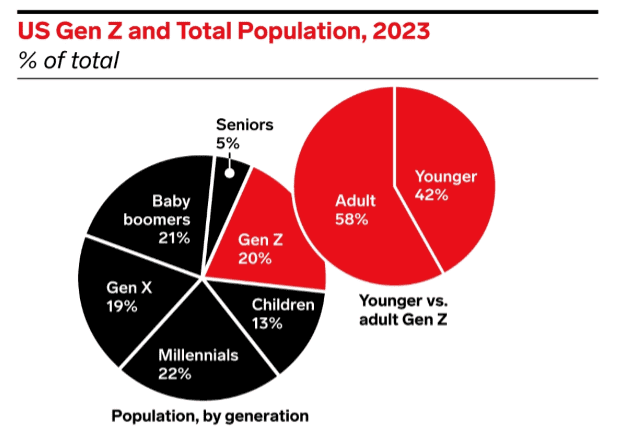
Gen Z and Gen Alpha: How to Reach the Next 2.5 Billion Shoppers With Dynamic Experiences
The youngest and most digitally native generations – Gen Z and Gen Alpha – don’t shop the way their parents and grandparents shop.
Gen Z is truly an omnichannel generation. They are shopping without a particular preference for how or where they find what they want, though they’re pretty much surgically attached to their phones.
Gen Alpha, typically the younger siblings of Gen Z, are still kids. They’re growing up during a time when the internet, smartphones, and access to ‘digital everything’ is nearly limitless.
Collaboratively, these younger generations won’t remember not being able to shop online.
They’re accustomed to making purchasing decisions quickly in an environment that’s ready-made for their needs. They expect businesses to understand their buying preferences, design products around them, and offer dynamic experiences crafted specifically for them.

How young shoppers are changing everything
The Pew Research Center defines Gen Z as people born between 1997 and 2012, making them between the ages of 11 and 26. Gen Alpha is the generation after them, born between 2013 and now (aged 0 through 10).
Both generations have grown up in a world filled with apps, mobile devices, and smart speakers, making it easy to access the internet and shop online.
They’re comfortable buying from their phones, laptops, or any other device that connects them to the internet.
Globally, young people are winning the population game, with 40% of the world population made up of people under the age of 25.
In the U.S., Millennials comprise the largest chunk of the population at 22%, with Gen Z a close second at 20%.
In this chart from Insider Intelligence, Gen Z includes an age range of 18-26-year-olds, with 42% of them labeled as “younger” and 58% labeled as “adult.”

Shopping behaviors of Gen Z versus Gen A
While the two youngest generations are trendsetters when it comes to shopping habits, they have some slight, but not insignificant, differences when it comes to preferences and behaviors.
Gen Z is:
- Social – They typically discover new products from YouTube ads, social media, and search.
- Impulsive – About a quarter of them often make impulse purchases.
- Online (a lot) – Over 70% shop online, with 60% doing so at least once a week.
- Sustainable – 73% are willing to pay more for sustainable products.
Gen Alpha is:
- Conscientious – 66% prefer buying from companies who make a positive difference in the world.
- Mobile (and beyond) – Their future shopping plans involve mobile devices, physical stores, telepathy, and voice assistants.
- Social – They’re even more social-media focused than their Gen Z peers, with a third planning to use social media to shop once they’re old enough to do so on their own.
Most of Gen Z (even the youngest members) have some level of buying autonomy. They have jobs, or they’re driving, or they just started college with a fresh credit card in their virtual wallets.
By comparison, Gen Alpha is still forming. They’re children (or infants) who are growing up immersed in a digital retail ecosystem.
Dynamic shoppers need dynamic experiences
Both generations of young shoppers are dynamic. They’re less interested in brick-and-mortar traditional retail experiences than older generations.
They shop across a connected ecosystem of online and offline channels which typically starts on their phones, on social apps like TikTok or Instagram.
They’re also impatient. When they’re interested in something recommended by a friend, influencer, or ad, they don’t like sifting through pages and pages of products on your website to find it.
To keep up with this tendency for constant movement and instant gratification, businesses must find ways to create trust, customize and personalize shopping experiences, and connect with their younger customers authentically.
Here are a few examples of building meaningful dynamic experiences that will resonate with Gen Z and eventually Gen Alpha:
- Embrace mobile apps and social media – Gen Z and Gen Alpha grew up with smartphones at their fingertips. They are used to the ease and accessibility of finding products and interacting with brands through social media platforms or mobile apps. Creating an engaging app for shopping or making it easy to shop from Instagram and TikTok go a long way in meeting these consumers where they are. Audience Discovery tools and creating campaigns based on their interests and behaviors will keep them interested and engaged with your brand. Keeping personalized experiences fun, dynamic, and meaningful to Gen Z and Gen Alpha’s sensibilities will help successful brands cultivate and grow this unique customer base.
- Make product discovery fun and easy – Because they spend so much time on social media and digital platforms, it’s important to build a customer journey that enables them to quickly find products and make fast purchases. Product Recommendations on a mobile app or directing shoppers to a simple page with just lipsticks or just boots based on tailored campaigns make it easy to locate products without choice overload. Offering an interactive, fun quiz with a Product Finder is another fun way to boost engagement and to help Gen Z and Gen Alpha to find new products.
- Leverage social proof and influencers – Product endorsements from real customers leveraging social proof experiences are key in building trust for Gen Z and Gen Alpha. They take comfort in endorsements from real customers. In addition, since this audience embraces shopping from Instagram and TikTok, social proof is especially powerful for traffic coming in from social channels. Influencers are also important for Gen Z and Gen Alpha who follow celebrities and other movers and shakers that they admire for insight and advice on what products to purchase. Having an ambassador that shoppers can connect to and engage with on social media will greatly enhance product discovery, add-to-cart, conversion and AOV.
- Open the mobile wallet – Offering additional ways to make purchases other than credit cards or cash in-store goes along way with this group. Mobile payment options like Apple Pay and Google Pay make it even easier to make purchases by streamlining the whole process for Gen Z and Gen Alpha who are never far from their smartphones.
It’s important to never forget that Gen Z and Gen Alpha don’t “shop “or “purchase” the way their parents do.
For them, shopping is more than just buying items. It’s an experience that incorporates entertainment, discovery, and connection.
This is quite a shift away from how older generations shop. The savviest businesses will be the ones that can still respect their older, more traditional shopping base, while creating new personalized experiences for Gen Z and Gen Alpha to stay relevant.
Brand Ambassadors as Influencers + Bulk™
Learn how Bulk™ provides custom UTMs to brand ambassadors to share with their social media followers.
How do you prepare for what’s coming next?
Businesses are now facing a pivotal moment in the way they interact with shoppers.
Younger generations have always been trendsetters and brand influencers, but Gen Z and Gen Alpha are different. They’re driven by values like sustainability and motivated by meaningful, easy and quick shopping experiences.
All of this is forcing companies to rethink what a modern shopping journey looks like.
To prepare for this shift, start with the basics. Then you can build from this solid foundation.
Invest in technology that enables you to understand your customers and tailor dynamic experiences around them.
This includes:
- Enhancing your data and analytics capabilities – Make sure you’re collecting all your customer data across channels, devices, and touchpoints. It should be unified, so you have a single view of your customers and can create personalized experiences. Understanding things like where your website visitors are coming from, the device they’re using, their geographic location, and if they were referred by an ad can help you tailor your landing pages and other content.
- Investing in an advanced personalization engine – This is what allows you to deliver customized experiences for each shopper (at scale). Advanced personalization goes beyond making product recommendations by allowing you to display content and creative assets using AI-driven algorithms that match website visitors to appropriate information.
- Embracing automation – You need the ability to scale personalized experiences across channels. Automation can help you create automated workflows that trigger emails and messages, leverage insights from customer segmentation for more nuanced experiences, and provide a consistent experience to customers regardless of where they interact with you.
- Being ready to scale – Technology evolves at a rapid pace, so be prepared to update your systems with the latest upgrades and add solutions, channels, and capabilities as needed. Be ready to pivot as new trends emerge, listen to customer feedback and opinions, and be mindful of the values held by younger generations.
Gen Z and Gen Alpha are a new breed of shoppers
They’re comfortable using the tools and technology that older generations are learning to navigate but may not fully embrace.
While you can’t predict every new trend or behavior, this isn’t about being clairvoyant. It’s about making sure the building blocks are in place to give yourself the best chance of success.
By understanding the motivations and preferences of young shoppers and investing in the right technology to anticipate their needs, you’ll be prepared to deliver the shopping experience of the future with dynamic experiences.